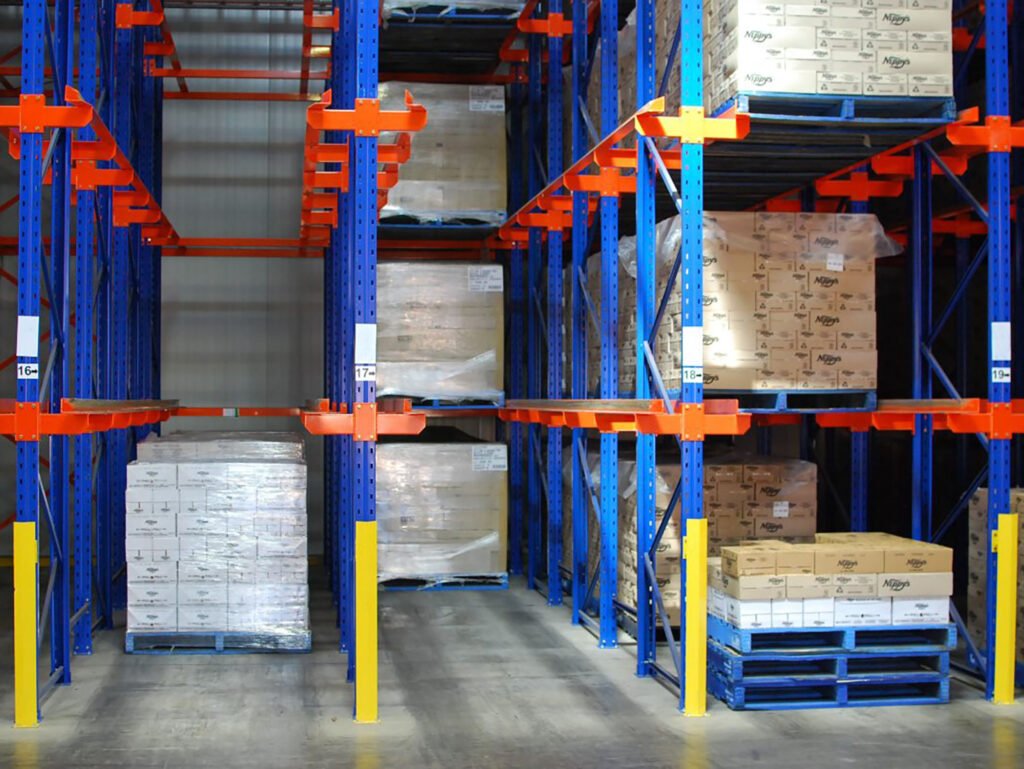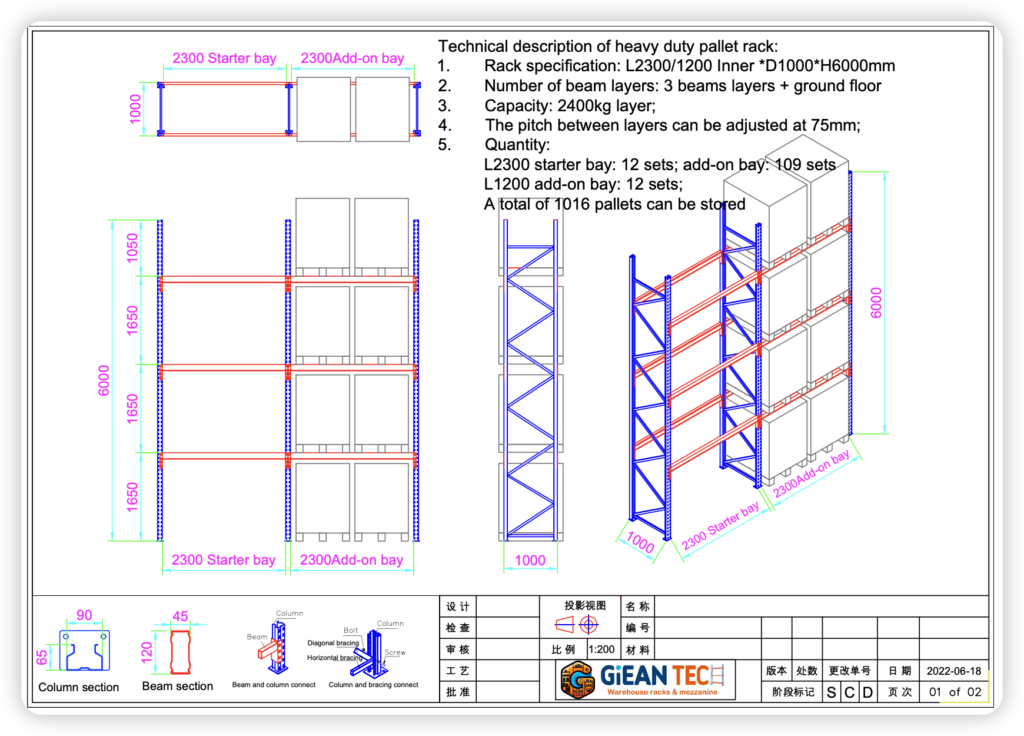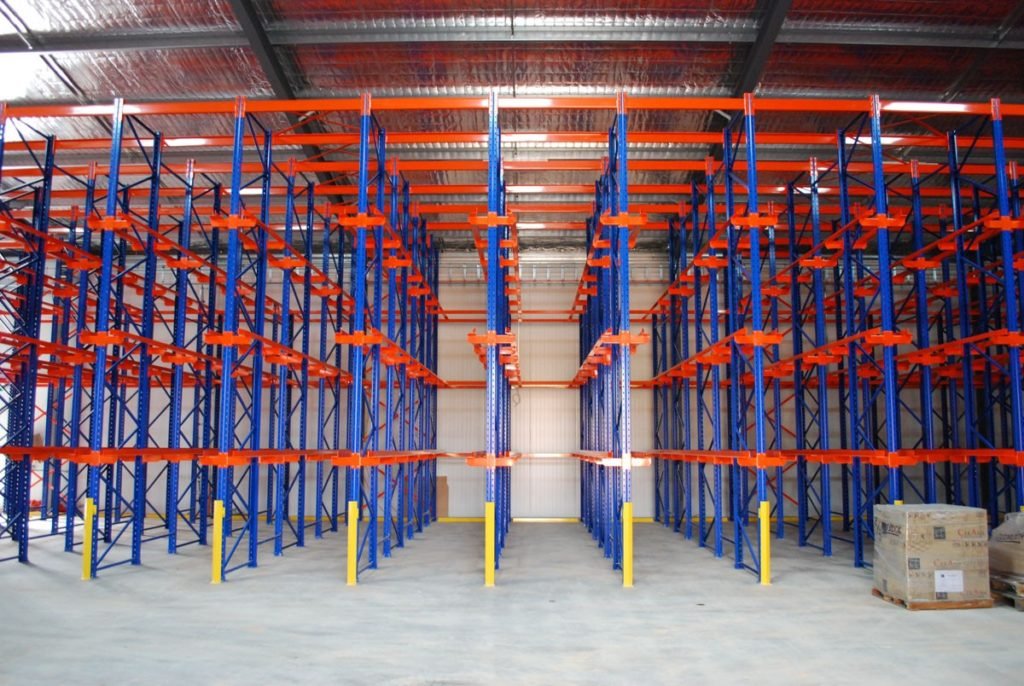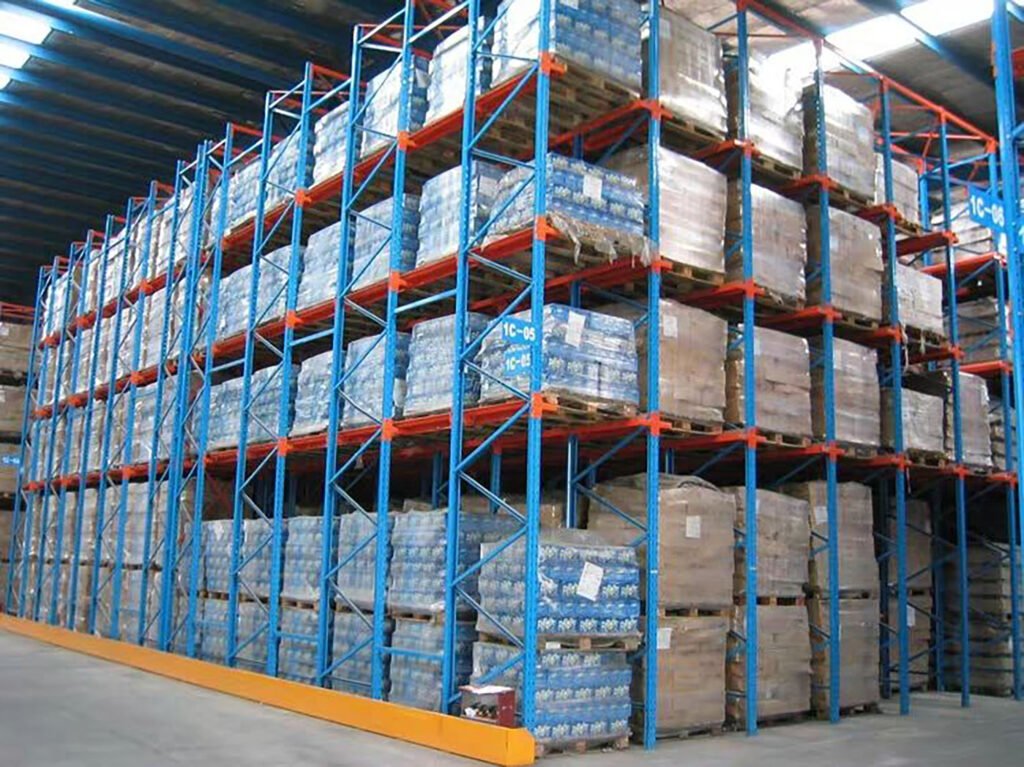Drive-in Racking System

What Is Drive-in Racking System
Drive-in racking is a racking system designed for high-density storage. Its main features are as follows:
Continuity of the whole rack: The drive-in rack has no channel to separate it, and the entire racking system shows the characteristics of continuity.
Support guide rail: the rack is provided with a support guide rail, the tray is stored according to the depth direction, arranged one by one, forming a high-density storage structure.
Access method: Forklift or other handling equipment can be directly driven into the rack for goods access, access efficiency is high.
Arrangement: According to the direction of picking up goods, drive-in racking can be divided into one-way arrangement and two-way arrangement. Unidirectional rack wall area, the total depth is usually controlled within the range of 6 pallets; The two-way racks are in the middle area, and the goods can be taken from both sides, and the total depth is generally controlled within the range of 12 pallets.
Customizable Drive-in Racking System
The size of the drive-in rack is a comprehensive consideration, which is affected by a variety of factors, including the type, quantity, weight, size of the storage items, as well as the roof height and layout of the warehouse
| Rack Width(mm) | Rack Depth(mm) | Rack Height(mm) | Load Capacity |
|---|---|---|---|
| 2300-3500mm | 800-1100mm | <13500mm | 1000-4000KG |
| Customizable | / | / | / |
The process of Giean warehouse storage solution drawing design

Firstly, we need to determine the size of your warehouse in order to create a space-saving layout drawing tailored to your specific warehouse dimensions.

Next, we will design a rack structure diagram, which can more intuitively reflect how you can store and retrieve goods conveniently, quickly and safely.

After confirming the previous drawings, we will create a more three-dimensional 3D drawing based on them to enhance the overall effect.
Why Choose Giean Drive-in Racking System
1.High space utilization: Since there is no need to set up a separate forklift channel for each row of racks, all forklifts share one or a few channels, greatly reducing non-storage areas, and improving warehouse utilization by more than 50% compared to traditional racks.
2.Safe and stable: The combination of high-strength cold-rolled steel welded, high strength is not easy to deform, and easy to install and disassemble.
3.Large storage capacity: each channel can be set on both sides of the multi-layer cargo, to adapt to different sizes of goods, by adjusting the height of the beam, can store a large number of the same type of goods, especially suitable for storing large quantities, single varieties of products.
4.Low cost: Because it can greatly increase the storage capacity per unit area, thus reducing the cost per unit of freight space, it is an obvious advantage for large-scale warehousing operations in pursuit of economy.
5.Flexibility: It can be designed and customized according to the actual needs of customers to meet the storage needs of different industries.
Application Of Drive-in Racking System

For cold stores that need to maintain a low temperature environment, drive-in racks can greatly increase storage capacity and reduce the surface area of cold air loss, thereby reducing energy consumption and operating costs.

Products involving a large number of standardized packaging, such as bottled beverages, canned food, etc., these goods are large and uniform in size, suitable for intensive storage by drive-in racks.

Wholesalers and large retailers can greatly improve the storage capacity of warehouses in the pre-holiday promotion phase, ensuring that there is enough inventory to meet the large number of shipments in the short term.
The following factors need to be considered when selecting the appropriate drive-in rack

Include the ground bearing capacity, space size, and height restrictions of the warehouse.

The size, weight, frequency of access and whether special storage conditions (such as temperature and humidity control) are required.

Whether there is a suitable handling equipment (such as forklift, stacker, etc.) and the operation requirements of the equipment.

Select cost-effective drive-in rack type and configuration according to the budget.
Frequently Asked Questions About Drive-in Racking System
Drive-in racking systems allow multiple pallets to be stored in the same row of racks, creating deep storage by reducing the width of the aisle between racks (the “drive-in” area). This method greatly improves the utilization of space, compared with traditional racks, its storage density can be increased by 50% to 100%, especially suitable for warehouses that need to store a large number of similar goods.
Safety is one of the key considerations in the design of drive-in rack systems. The system is usually equipped with collision protection, such as a column protector installed at the front of the rack and an indicator system to alert the forklift driver to avoid collisions. In addition, proper forklift training and warehouse management systems, such as setting speed limits and clearly identifying storage areas, are also important means to ensure safe operation.
Although the drive-in rack system needs to consider future storage needs in the initial layout, it is not unadjustable. As your business grows, you can increase the flexibility of your system by rearranging the rack layout, adjusting the height or depth of storage, and installing removable partitions. However, adjustments to drive-in racks may require more planning and resource investment than other types of racks.
The cost effectiveness of the drive-in rack system is mainly reflected in its high storage density, which reduces the overall cost by reducing the need for warehouse space and reducing the cost of land. At the same time, efficient access operations can reduce labor and time costs. However, it is also important to note the high construction costs and possible adjustment costs of the initial investment. Therefore, a number of factors need to be taken into account when assessing cost-effectiveness.
Drive-in rack systems provide flexibility to implement FIFO or LIFO strategies. In order to achieve FIFO, the access operation is usually carried out from the same end of the rack, ensuring that the earliest stored goods are removed first. LIFO strategies may involve access operations from different depths of the rack, but this is less common in drive-in racks because it reduces access efficiency. The storage strategy needs to be clearly defined in the design and reflected in the rack layout and operation process.
The drive-in rack system has certain requirements for the environmental conditions of the warehouse. First of all, the warehouse floor should be smooth, solid and no obvious slope to ensure smooth driving of forklifts and stable racks. Secondly, good ventilation and lighting conditions should be maintained in the warehouse to ensure the safety and comfort of the operator. In addition, the warehouse should also consider temperature and humidity control, fire prevention and theft and other safety measures.
The drive-in rack system is particularly suitable for storing goods with large batches, small types and moderate weights. These goods usually do not require frequent picking, but are stored and taken out as whole units. For example, warehouses in food, beverage, chemical raw materials, building materials and other industries often use drive-in racking systems to improve storage efficiency and space utilization.
The daily maintenance and maintenance of the drive-in rack is crucial. This includes regularly checking whether the rack structure is stable, whether the connector is loose, and whether the surface is damaged. At the same time, it is also necessary to clean the dust and debris on the racks to keep the racks clean and tidy. For the problems found, the damaged parts should be repaired or replaced in time to ensure the safety and stability of the rack system. In addition, regular maintenance and maintenance of access equipment such as forklifts is also necessary.
Leave Your Email And Our Latest Catalogue Will Be Sent To You!






